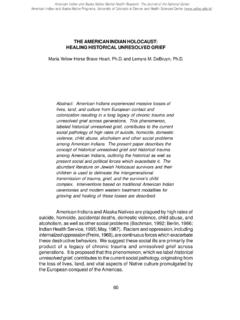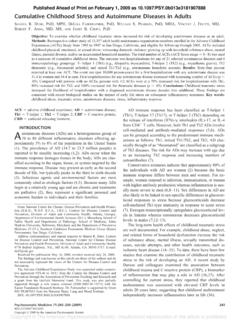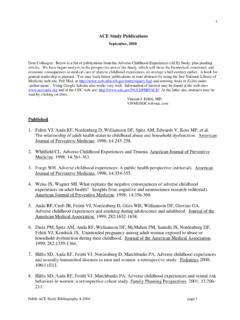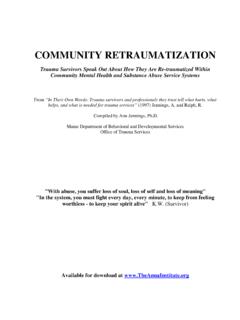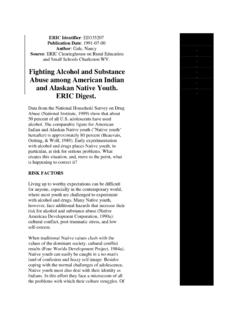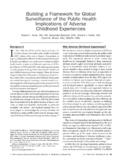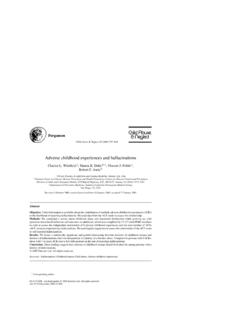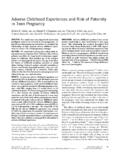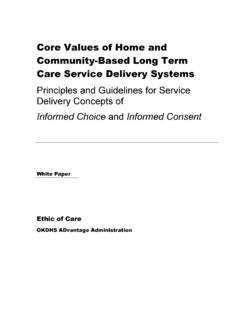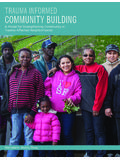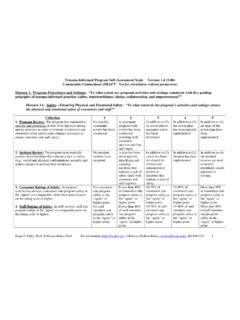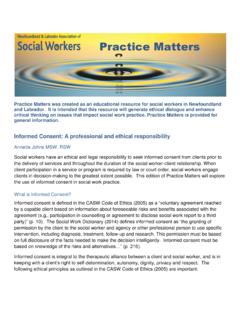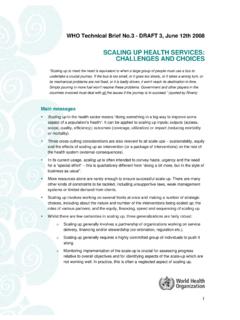Transcription of Creating Cultures of Trauma-Informed Care (CCTIC): …
1 Creating Cultures of Trauma-Informed Care (CCTIC): A Self-Assessment and Planning Protocol Community Connections; Washington, Roger D. Fallot, and Maxine Harris, April, 2009 Introduction Over the past fifteen years, there has been growing acknowledgement of several interrelated facts concerning the prevalence and impact of trauma in the lives of people in contact with various human service systems. We advocate for Trauma-Informed service approaches for a number of reasons. Trauma is pervasive. National community-based surveys find that between 55 and 90% of us have experienced at least one traumatic event. And individuals report, on average, that they have experienced nearly five traumatic events in their lifetimes. The experience of trauma is simply not the rare exception we once considered it.
2 It is part and parcel of our social reality. The impact of trauma is very broad and touches many life domains. Trauma exposure increases the risk of a tremendous range of vulnerabilities: mental health problems like posttraumatic stress disorder, depression, excessive hostility, and generalized anxiety; substance abuse; physical health problems; interpersonal struggles; eating disorders; and suicidality, among many others. Trauma thus touches many areas of life not obviously or readily connected with the experience of trauma itself. This broad impact makes it particularly important to understand the less evident links between trauma and its sequelae. The impact of trauma is often deep and life-shaping. Trauma can be fundamentally life-altering, especially for those individuals who have faced repeated and prolonged abuse and especially when the violence is perpetrated by those who were supposed to be caretakers.
3 Physical, sexual, and emotional violence become a central reality around which profound neurobiological and psychosocial adaptations occur. Survivors may come to see themselves as fundamentally flawed and to perceive the world as a pervasively dangerous place. Trauma may shape a person s way of viewing and being in the world; it can deflate the spirit and trample the soul. Violent trauma is often self-perpetuating. Individuals who are victims of violence are at increased risk of becoming perpetrators themselves. The intergenerational transmission of violence is well documented. Community violence is often built around cycles of retaliation. Many of our institutions criminal justice settings, certainly, but also schools and churches and hospitals are too frequently places where violent trauma is perpetuated rather than eliminated.
4 Community Connections/Version 4-09 2 Trauma is insidious and preys particularly on the more vulnerable among us. People who are poor, who are homeless, who have been diagnosed with severe mental health problems, who are addicted to drugs, or who have developmental disabilities all of these groups are at increased risk of violent victimization. Trauma affects the way people approach potentially helpful relationships. Not surprisingly, those individuals with histories of abuse are often reluctant to engage in, or quickly drop out of, many human services. Being vigilant and suspicious are often important and thoroughly understandable self-protective mechanisms in coping with trauma exposure. But these same ways of coping may make it more difficult for survivors to feel the safety and trust necessary to helpful relationships.
5 Trauma has often occurred in the service context itself. Involuntary and physically coercive practices, as well as other activities that trigger trauma-related reactions, are still too common in our centers of help and care. Trauma affects staff members as well as consumers in human services programs. Stressors deeply affect administrators, clinicians, and support staff working in human services. Not only is secondary or vicarious traumatization common but direct threats to physical and emotional safety are also frequent concerns. Being asked to do more and more with less and less becomes a pervasive theme underlying work experiences that may threaten to overwhelm coping abilities. Growing awareness of these facts regarding trauma has led to calls for the development of both Trauma-Informed and trauma-specific services.
6 Human service systems become Trauma-Informed by thoroughly incorporating, in all aspects of service delivery, an understanding of the prevalence and impact of trauma and the complex paths to healing and recovery. Trauma-Informed services are designed specifically to avoid retraumatizing those who come seeking assistance as well as staff working in service settings. These services seek safety first and commit themselves to do no harm. The SAMHSA-funded Women, Co-Occurring Disorders, and Violence Study (1998-2003) has provided evidence that Trauma-Informed approaches can enhance the effectiveness of mental health and substance abuse services. By contrast, trauma-specific services have a more focused primary task: to directly address trauma and its impact and to facilitate trauma recovery.
7 An increasing number of promising and evidence-based practices address PTSD and other consequences of trauma, especially for people who often bring other complicating vulnerabilities ( , substance use, severe mental health problems, homelessness, contact with the criminal justice system) to the service setting. This Self-Assessment and Planning Protocol and its accompanying CCTIC Program Self-Assessment Scale attempt to provide clear, consistent guidelines for agencies or programs interested in facilitating Trauma-Informed modifications in their service systems. It is a tool for administrators, providers, and survivor-consumers to use in the development, implementation, evaluation, and ongoing monitoring of Trauma-Informed programs. Community Connections/Version 4-09 3 Overview of the Change Process, Protocol, and Scale Culture Change in Human Service Programs The Creating Cultures of Trauma-Informed Care approach to organizational change is built on five core values of safety, trustworthiness, choice, collaboration, and empowerment.
8 If a program can say that its culture reflects each of these values in each contact, physical setting, relationship, and activity and that this culture is evident in the experiences of staff as well as consumers, then the program s culture is Trauma-Informed . We emphasize organizational culture because it represents the most inclusive and general level of an agency or program s fundamental approach to its work. Organizational culture reflects what a program considers important and unimportant, what warrants attention, how it understands the people it serves and the people who serve them, and how it puts these understandings into daily practice. In short, culture expresses the basic values of a program. Culture thus extends well beyond the introduction of new services or the training of a particular subset of staff members; it is pervasive, including all aspects of an agency s functioning.
9 In order to accomplish this culture change, we strongly recommend several steps: 1) Initial Planning. In this phase, the program considers the importance of, and weighs its commitment to, a Trauma-Informed change process. The following elements are key to the successful planning of organizational Trauma-Informed change: a) administrative commitment to and support of the initiative (see Domain 4 below); b) the formation of a trauma initiative workgroup to lead and oversee the change process; c) the full representation of each significant stakeholder group on the workgroup administrators, supervisors, direct service staff, support staff, and consumers; d) identification of trauma champions to keep the initiative alive and on the front burner; e) programmatic awareness of the scope (the entire agency and its culture) and timeline (one to two years) of the culture shift.
10 Discussions of Trauma-Informed program modifications constitute an opportunity to involve all key groups in the review and planning process. In our experience, the more inclusive and fully representative these discussions are, the more effective and substantial the resulting changes. 2) A Kickoff Training Event. Usually two days long, the kickoff training is attended by as many of the staff as practical and includes significant consumer representation; it certainly includes all members of the trauma initiative workgroup. During this event, there are at least three presentations. In the first, central ideas of Trauma-Informed Cultures are presented, emphasizing shifts in both understanding and in practice. In addition, the importance of staff support and care is emphasized.

